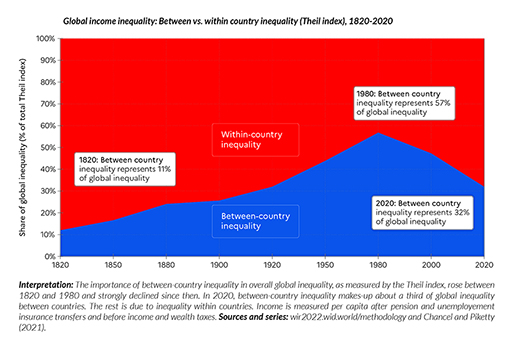2 Why the four key development challenges?
In the previous sections you read about how global issues affect and connect people and places across the globe. Problems caused by hunger, poverty, and migration have led to planned and purposeful interventions seeking to address the issues and to improve the lives of those affected. Yet patterns of poverty persist throughout the world, with evidence that any decrease in inequalities between countries is being offset by the increases in inequalities within countries.
‘In 2021, after three decades of trade and financial globalisation, global inequalities remain extremely pronounced: they are about as great today as they were at the peak of Western imperialism in the early 20th century.’

Inequality is an example of an entrenched, enduring problem that seemingly defies all attempts to change it for the better. If anything, the data indicates a worsening of the situation. What is critical to realise is that inequality of income is but one fragment of the story. Inequality of income intersects with inequalities related to accessing education and healthcare. For instance, maternity mortality rates in low-income countries in 2017 was 462 per 100 000 live births compared to 11 per 100 000 live births in high-income countries, with most of these deaths being preventable if skilled healthcare is provided (WHO 2021).
Doing more of the same is unlikely to be the answer. The situation requires that we step back, reflect and ask ‘What is going on here? What is pushing against change? Who benefits from the status quo?’
Activity 1: World Inequality Report 2022
Read the following extract from the executive summary of the World Inequality Report 2022. If you would like to delve deeper into this issue, the full summary makes for fascinating and provocative reading. You can find the link in further reading.
The below extract concerns wealth rather than income. The net wealth of a country or an individual is the sum of their financial and non-financial assets, minus their debts.
Read the extract and reflect on its implications. What do you think governments can do in such a situation?
‘Nations have become richer, but governments have become poor’
‘One way to understand these inequalities is to focus on the gap between the net wealth of governments and net wealth of the private sector. Over the past 40 years, countries have become significantly richer, but their governments have become significantly poorer. The share of wealth held by public actors is close to zero or negative in rich countries, meaning that the totality of wealth is in private hands. This trend has been magnified by the Covid crisis, during which governments borrowed the equivalent of 10-20% of GDP, essentially from the private sector. The currently low wealth of governments has important implications for state capacities to tackle inequality in the future, as well as the key challenges of the 21st century such as climate change.’
Comment
The situation is one where the private sector has far more control over wealth and how it is used than governments have. This is of course an overall picture and varies in extent from country to country. It is critically important as this wealth enables governments to invest in infrastructure, education, health and environmental protection systems, and to address inequalities in access to public services. What governments can do is to impose taxes, regulate trade and enforce standards. Redistributing wealth is seen as a key strategy to addressing inequality and to investing in a better future for all (The World Inequality Report 2022, Chapter 7). However, doing so is highly political and contested. Altruistic wealthy individuals also voluntarily redistribute wealth, and it is worth exploring the impacts of such actions. Nothing is ever wholly one-sided.
The issue of persistent global income and wealth inequality, with that within countries increasing, even in developed countries, provokes questions on the very nature of development. It calls for recognition that the model of modernisation and industrialisation, promoted by Western democracies, does not equate with just and fair distribution of the benefits, nor does it support environmentally sustainable lifestyles.
Reflecting on this issue of income and wealth inequality, the four challenges identified in this course - conflict, governance, justice and transformation- encapsulate the thorny questions that need to be asked if development principles of justice, peace and equity are to prevail.
- The present global economic system benefits some greatly. Changing it to benefit others will have to push against a very entrenched way of working and the interests of those who currently benefit most from it. How do we negotiate the competing interests of the ‘haves’ and ‘have nots’? This raises the challenge of working with conflict.
- If, for example, wealth redistribution is seen as essential to addressing inequality, who will decide what is best and at what scale? How do we identify and enforce the ‘rules’ through which we manage socio-economic processes? These represent questions of governance.
- These in turn raise questions of justice. Who will evaluate the change that takes place and using which criteria? How do we work out what ‘good change’ looks like?
- The present global economic system has changed in various ways over the years yet still results in growing inequalities. How do we achieve meaningful change, especially in the face of long-standing, deeply entrenched socio-economic systems? This is the challenge of transformation.
